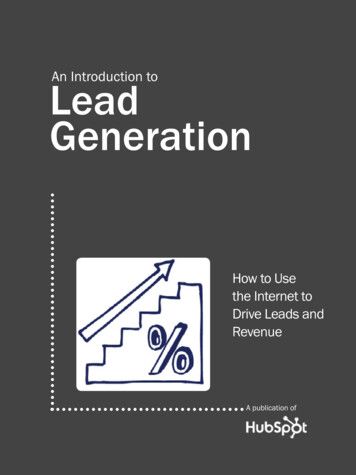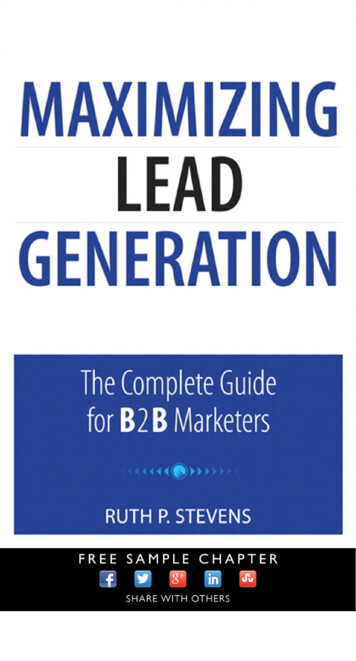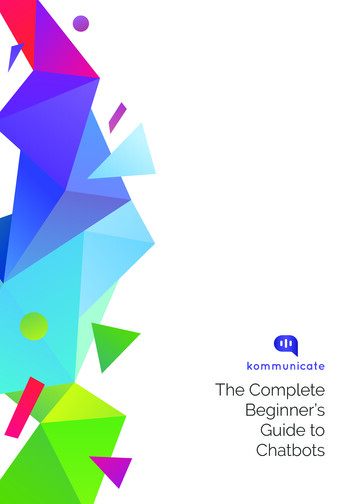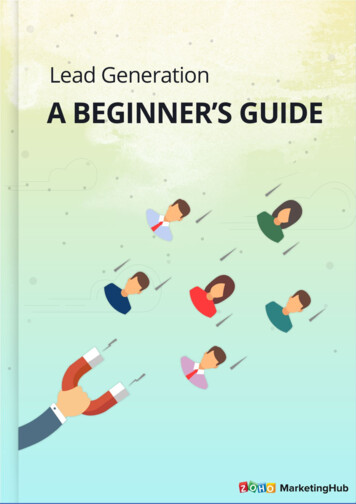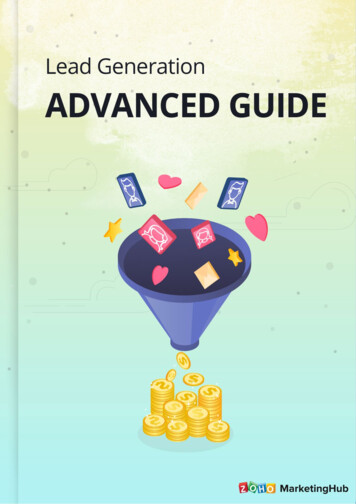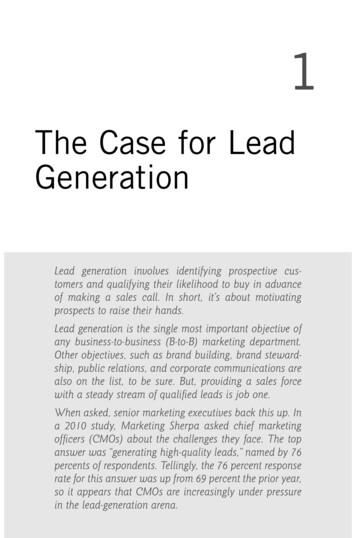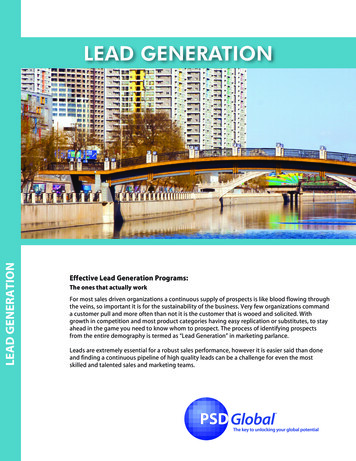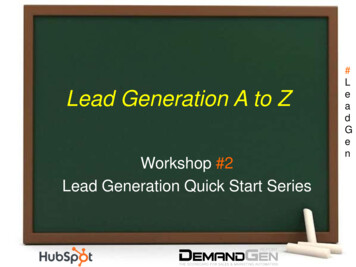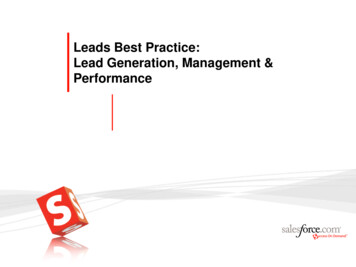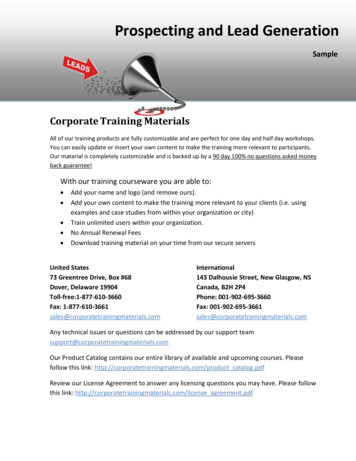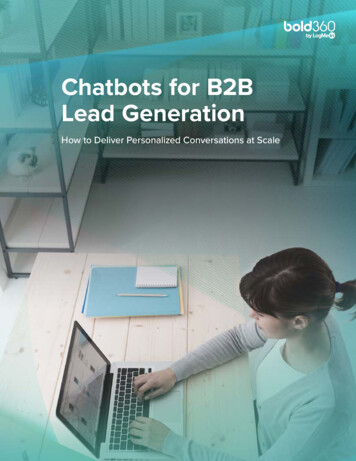
Transcription
Chatbots for B2BLead GenerationHow to Deliver Personalized Conversations at Scale
“ Today’s B2B consumersare increasingly similarto their B2C counterpartsin the way they shop forproducts and services.They’re in command of thebuying journey, learningabout products andservices via social feeds,websites, rankings, andreviews long before theyever engage with sellers.”If you’ve been on an ecommerce website lately, there’sa good chance you interacted with a chatbot. They’rebecoming increasingly popular, almost ubiquitous, onB2C websites for customer service and support. And itmakes perfect sense: customer support agents deal witha huge volume of customer inquiries, many of them repetitive. Today’s modern AI chatbots with Natural LanguageUnderstanding (NLU) and Machine Learning (ML) havebeen able to step in and handle routine inquiries fromcustomers, freeing agents to spend their time on morecomplex interactions.But there are many other use cases for chatbot technology, including lead generation and qualification, customerconversion, internal employee support, and even personalassistants. In this paper, we’ll take an in-depth look at chatbots in business-to-business lead generation.Many B2B marketers have already added chatbots to theirtechnology mix in response to changing B2B buyer behaviors. Today’s B2B consumers are increasingly similar totheir B2C counterparts in the way they shop for productsand services. They’re in command of the buying journey,learning about products and services via social feeds, websites, rankings, and reviews long before they ever engagewith sellers. The challenge for B2B companies is intercepting these empowered B2B consumers and converting theminto actual leads. That’s where chatbots come in.CHATBOTS FOR B2B LEAD GENERATION 2
The problem:Turning website visitors into leadsToday’s B2B consumers are increasingly likely to do theirinitial research on products and services online. Accordingto Forrester, 68% of B2B buyers in 2017 preferred to researchonline on their own, up from 53% in 2015.168% of B2B buyersin 2017 preferredto research onlineon their own, upfrom 53% in 2015.In response, modern B2B marketers are trying to make thatdiscovery process as frictionless as possible by improvingtheir site navigation and adding contextual search tools.2They’re also spending millions on digital content and marketingefforts to attract consumers to their websites so that theycan do that research.Where many companies stumble, however, is converting thoseself-service consumers into actual leads. As a result, they’re notgetting a good return on their marketing investment.Chatbots add value to B2B marketing by “helpingbuyers progress further into their purchase journeys,improving conversions along the way, and ultimatelygenerating more revenue.” — F ORRESTER, The Forrester Tech Tide: B2B MarketingTechnologies, Q4 2018, October 25, 2018Lead generation requires a personal touchSelf-service research can only take a customer so far—especially when it comes to higher value products and services.When prospects are ready to engage, they want a highly personalized, consultative experience based on an understandingof their unique business needs, and where they are in theirbuying journey.In the past, gaining that understanding happened throughphone calls from sales representatives. Reps reached out toconsumers and gathered information about their specific challenges, then shared examples of how their company’s serviceor solution helped others with similar needs.CHATBOTS FOR B2B LEAD GENERATION 3
“ By a factor of morethan 3 to 1, today’s selfdirected buyers preferto find the contentthey’re looking for earlyin their buying journeyrather than speakingwith a sales rep.”FORRESTER, Success with Bots and Virtual Assistants Depends on TheHuman Element, April 9, 2018Now, businesses hope to acquire leads throughtheir websites. For many businesses, that meansusing forms to capture preliminary informationabout site visitors. But the overuse of email blaststo large mailing lists has left people wary ofsharing their contact information. Nobody wants tobe spammed. These days, people are less willingto give you their information unless they believeyou will provide them with something of valuein return—that is, something relevant to theirspecific needs.Personal touch at scale is extremely expensive.Compounding the challenge is the problem ofscale. Engaging with B2B consumers throughindividual outreach by sales representatives vialive chat or call-back is extremely expensive giventhe volume and speed of traffic so many B2Bwebsites see. Companies couldn’t possibly staffenough agents to reach out to every site visitor.It’s far more efficient to keep representatives freefor high-value activities later in the sales journey,rather than with early-stage data gathering androutine inquiries. Unfortunately, this means thatmany users leave websites before businesseshave a chance to connect with them.Valuable contextual data is being lefton the table.Browser cookies and real-time data about whatvisitors are looking at and doing on your websiteoffer a wealth of potential insights—their geographic location, what other sites they’ve visited,which areas of your site they’re interacting with,and more. But most companies don’t have themanpower to cope with the volume and velocityof incoming data, let alone act on it in a timelymanner with personalized outreach.CHATBOTS FOR B2B LEAD GENERATION 4
The solution: AI Chatbots81%81% of B2B buyershave left a pagebecause they didn’twant to fill out a form.AI-powered chatbots can help companies captureleads more effectively online by engaging consumerswith personalized, contextual information at scale.By leveraging AI chatbots, you can interact withprospects in a more intelligent way, creatingopportunities to establish new relationships, convertmore sales, and prevent customer churn.Forrester believes chatbots can add value to B2B marketing by“helping buyers progress further into their purchase journeys,improving conversions along the way, and ultimately generating more revenue.”3Engage users with relevant, contextual information.One of the main reasons businesses fail to capture leads isthat they can’t offer relevant information at the right time.Customers may bounce from your site to a competitor’s ifthey can’t find the content they’re looking for, or if they’returned off by an intrusive pop-up window or canned chatmessage. They’re also more likely to bounce from your sitethan fill out a form.4AI chatbots stop the churn at that critical juncture in the buyingjourney with relevant, personalized content. Even consumersvisiting your site for the first time bring with them data thatchatbots can leverage, including demographics, location, andbrowsing history. Chatbots can use this data to engage theuser with information and support that will be relevant to them,guiding their research without an overt sales pitch.AI chatbots can even use third-party data to discern the difference between a first-time visitor, a qualified lead, and anexisting customer, and deliver personalized conversationsbased on stage, behavior, or profile. And they can do it inan unobtrusive way, with side or floating widgets instead ofin-your-face popups.CHATBOTS FOR B2B LEAD GENERATION 5
The solution: AI ChatbotsGive consumers conversations, not blanks to fill in.Early chatbots were little more than glorified decision trees.Today’s AI chatbots use natural language processing (NLP)and natural language understanding (NLU) to interact withprospects in a natural, conversational manner. You can alsoembed rich content like videos and images right in the chatwindow, so the content is more enticing.Some companies worry that consumers will be turned off by the“creepy factor” of chatbots. But as AI solutions become moreprevalent, consumers’ skepticism or reluctance to engage witha bot is decreasing: Within the global chatbot market, approximately 45 percent of users prefer chatbots as the primary modeof communication for customer service inquiries.584%84% of businesspeopleare more likely to buyfrom a website withproduct informationin their own language.Engage users globally in their native languageChatbots can automatically translate messages into just aboutany language, so you can engage every visitor in their preferredlanguage at a very low cost. This capability makes it affordablefor businesses to scale engagement to website visitors across theglobe. And localization matters for corporate buyers. CommonSense Advisory surveyed businesspeople with purchasing authority at 400 companies across 10 non-English-speaking countriesand found that 84% are more likely to buy from a website withproduct information in their own language.6Keep sales reps free to focus on consultative sellingChatbots can help B2B marketers remove friction from theearliest stages of the buying process, automate administrativetasks, and deflect calls and chats with expensive human agents.Sales representatives can focus on the consultative sellingconsumers want later in the buying journey, armed with thevaluable context and history the chatbot has gathered. Freedfrom time-intensive, repetitive tasks, sellers can spend moretime closing deals.CHATBOTS FOR B2B LEAD GENERATION 6
Mistakes to AvoidAs with any technology, AI chatbots need to be deployedthoughtfully if you want to get their full benefit and avoidbacklash from customers. Here are three common mistakes:Over-engaging.Just as you wouldn’t want your sales team to make too manyphone calls to the same person, you shouldn’t bombard a website visitor with messages or content. Keep in mind that today’sB2B consumers prefer to do their research independently,rather than have to talk with sales reps, or be pestered bypop-up windows. A single message at the right moment withthe right content will be most effective.Not being transparent.Nobody wants to feel like they’ve been duped. It’s crucial tolet customers know up front when they’re interacting with abot vs. a real person. If you plan to give your chatbots namesor avatars, make it clear they’re virtual, not human, assistants /representatives. It should also be easy for prospects to requesta live representative while they’re chatting with a bot.Using a siloed chatbot.Like consumers, today’s business owners want to engage withother businesses across a variety of channels, so you need anomni-channel chatbot solution that can engage conversationally. Ideally, one chatbot solution should be leveraged acrossthe entire organization for marketing, sales, and support so youcan continue to use the insights learned in earlier stages of thecustomer journey as the prospect becomes a customer.CHATBOTS FOR B2B LEAD GENERATION 7
It’s time to make chatbots partof your B2B sales strategy.Today, your company’s website is more than likelythe first stop for B2B consumers who want tolearn more about your products and services, butaren’t yet ready to interact directly with your sellers. Instead of interrupting their exploration withannoying pop-up forms and widgets, draw themfurther into their buying journey with AI chatbotsthat offer up content and guidance that’s actuallyrelevant to them, in an engaging, conversationalformat. If they find the information you offer themvaluable, they’re much more likely to engage andshare their contact information. As a result, you’llreduce bounce rate, collect more qualified leads,and turn more prospects into buyers.CHATBOTS FOR B2B LEAD GENERATION 8
Sources1Forrester, The Birth of The B2B Consumer Landscape:The B2B Marketing Playbook, October 5, 20172Forrester, How Self-Service Research Changes B2BMarketing, May 13, 20163Forrester, The Forrester Tech Tide: B2B MarketingTechnologies, Q4 2018, October 25, 20184Forrester, Success with Bots and Virtual AssistantsDepends on The Human Element, April 9, 20185Forrester, Predictions 2018: The Honeymoon for AIIs Over: Success at Artificial Intelligence MeansHard Work — Treat It Like A Plug-In Panacea and Fail,November 9, 20176Common Sense Advisory, Why Localization Matters forCorporate Buyers: B2B Preferences for LocalizedWebsites and Products, Donald A. DePalma, Benjamin B.Sargent, and Robert G. Stewart, July 2014CHATBOTS FOR B2B LEAD GENERATION 9
Engage smarter.Deliver value, instantly, with a more human AI,platform and interface.Bold360 is an intelligent customer engagementsolution that provides businesses with actionablecustomer insights to efficiently deliver richer andmore personalized experiences in real time. Weprovide the digital channels and tools needed toengage and support consumers as they seamlesslymove across self-service and agent-assisted channels like chat, email, messaging and social.Visit www.bold360.com to learn more.Contact Us:866.753.9933info@bold360.comAll rights reserved, LogMeIn 2019 320 Summer Street, Boston, MA 02210
ogy, including lead generation and qualification, customer conversion, internal employee support, and even personal assistants. In this paper, we’ll take an in-depth look at chat-bots in business-to-business lead generation. Many B2B marketers have already added chatbots to their tec
